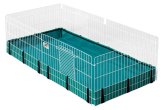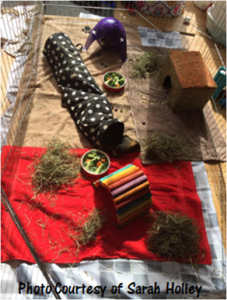Home Swheek Home
One search on google, pinterest, or instagram will show many different acceptable cage designs that are anywhere from very basic (but functional) to very fashionable with a complex design.
It’s important to note that your guinea pigs will be happy as long as they are going to be in a place of family activity, have a cage large enough for them, and are taken care of properly. They couldn’t care less how decorative the cage is*.
Cage Types Discussed are the following:
- C&C
- Midwestern
- Wood and Plexiglass
- Other
- Most Cost Effective
C&C
The C&C cage is by far one of the most popular due to the ease to construct and the cost factor. It allows any layout and design that can be imagined with plenty of space for pigs. The grids also help to secure the water bottle, hay rack (if that’s what you’re using), and decorative pieces.
C&C stands for Cubes and Coroplast Cages. It utilizes grids and coroplast on the bottom and sides to keep it easy to clean and it will contain materials in the cage. The grids allow ventilation to the guinea pigs and security so they don’t come out when you don’t want them to be free roaming.
C&C tends to be popular for the following reasons…
- Easy to Clean
- Easy to Put Together
- Easy to Design
- Has Color Choices
- Allows Customization (including levels, expansion, reduction, etc)
- Good Ventilation
- No External Tools Needed Besides a Knife and Glue (Cut and Secure Coroplast)
- Lightweight to Move Around
- Reusable as Storage Units (Grids)
- Easy to Disassemble if Need
- Can Customize to Protect from Other Animals (Cats, Dogs)
The biggest problem with C&C cages seems to be finding the materials, and if not that, then finding the correct sized grids.
Grids: Not all grids are made the same. For safety sake, any grids bought for the purpose of a guinea pig cage should have the inner holes be NO BIGGER than 1.5 inches. Any bigger, pigs have been known to get stuck in them which can lead to injury or death.

If there are baby guinea pigs, two grids can be used to overlap each other to make the holes smaller since baby guinea pigs are able to become stuck in the normal grid size.
While the pictures below have fleece, C&C cages can have any type of appropriate bedding for guinea pigs.
Finding Materials: Home Depot in the U.S. has coroplast, but sign shops may also have large sheets available for purchase. Before heading out and taking the time to drive around it may be a good idea for you to call and ask if they have any in stock. Some craft stores may carry it as well, though this has greatly varied by location. You can also order coroplast – though it may be more pricey – online.
Grids can also be found online, but many major stores – such as Target or Walmart – can carry them. This is especially true during back to school season (July-September). We bought ours at Bed, Bath, and Beyond because we found their grids were guinea pig safe and more affordable than other places we were looking at.
Sample C&C cages can be seen below with a single level and a loft version.

Midwestern
 One of our favorites in terms of ease of storage and cleaning. It also keeps bedding inside the cage well. We mostly love it if you have any other pets in the house such as a cat or dog since it had an option to have a stable grid top to ensure those animals don’t get in to bother or harm the guineas!
One of our favorites in terms of ease of storage and cleaning. It also keeps bedding inside the cage well. We mostly love it if you have any other pets in the house such as a cat or dog since it had an option to have a stable grid top to ensure those animals don’t get in to bother or harm the guineas!
Midwesterns have gotten in the hearts of guinea pig owners since it  requires the least amount of time in assembly, no tools at all are needed, and isn’t too cost consuming for the size (8 square feet). Additionally, if they need more space, it is easy to connect multiple midwestern cages together to enlarge the enclosure.
requires the least amount of time in assembly, no tools at all are needed, and isn’t too cost consuming for the size (8 square feet). Additionally, if they need more space, it is easy to connect multiple midwestern cages together to enlarge the enclosure.
 A midwestern cage has grids on the sides (and top if you buy the ‘Guinea Habit Plus’) and a green canvas bottom that is washable, easy to remove when needed, and leak proof.
A midwestern cage has grids on the sides (and top if you buy the ‘Guinea Habit Plus’) and a green canvas bottom that is washable, easy to remove when needed, and leak proof.
On Amazon the price for the normal ‘Guinea Habitat’ (no top) was approximately $37 (rounding up) and the ‘Guinea Habitat Plus’ was $44.
Sample Midwestern Cage is shown below. These are two separate cages next to each other.

Wood and Plexiglass
Probably made popular by the PiggyPigPigs’s YouTube Channel, wood (specially painted or treated to be water proof) and plexiglass made cages have risen in popularity in the guinea pig community. If done correctly it definitely brings a sense of ‘classiness’ to guinea pig cages. However, as with anything that looks more ‘classy’ and upscale, it had a hefty price tag that can come with it compared to the other options. Rekeito’s materials, excluding assembly materials (special glue, screws, etc) would have cost about $90-100 (this may vary by location) and that would have been a cage area size of 13-15 square feet. This is without sales, coupons, or rebates that might be available in other areas.
While this cage looks beautiful, this is a project for someone who is into handiwork and taking the patience to put it together. Wood and plexiglass cutting may be applicable, using drills, screws, and other equipment also is necessary to hold these cages securely. Additionally, these cages are not adaptable to space and special considerations must be made in regards to hanging the water bottle, what to do with hay, or etc.
However, if this is the cage type you have your heart set on – as Rekeito and I do for the future once we have our own houses – go for it!
Other
People have used appropriately sized/modified bookshelves, bookcases, and have gotten creative even with redone tables! The options are endless and it goes to show that you’re not stuck with just one way to build a cage.
Most Cost Effective Cage Option
One of the biggest questions we get is, “What’s the cheapest way I can ensure my guinea pigs have enough room?” Whether on a budget or not, it’s a reasonable question that plagued Ali as she searched for the best cost effective option for her pig.
After much research, we figured it out. The least amount of work, and cheapest, option is to use grids for the outside of the cage and use fleece bedding.
Components of the Cost Effective Cage
- Grids with holes that measure no more than 1.5 inches
- Grid connectors (this can be substituted for zip ties, twist ties, and some have used yarn/string)
- Fleece bedding: Fleece + Absorbent Layer(s)
- Shower liner (this can be substituted for anything waterproof)
| Object | Cost |
| Grids | $18 |
| Fleece | $6 |
| Uhaul Liner/Furniture pads | $8 |
| Shower Liner | $1 |
| Total | $33 |
This is the type of cage that Once Upon a Wheek guineas have and enjoy! We love it because it allows less money over time (due to less bedding being used), is very easy to clean, and the endless customization options allow it to fit whatever area we had.
Sample with Grids and Floor for Playpen, but could double as a cage if needed. Additional examples can be found by looking at Once Upon a Wheek‘s guinea pig enclosures of Cora, Kalsie, and Willow.

Final Note
Your cage design is just that, yours. All of these options have customization options in one way or another, and it depends what you and your pigs are looking for.
At the end of the day, all of these cage types are acceptable and would be a great place for your pet to make their own.
What do your cages look like? Share them in the comments!
*Disclaimer: Perhaps they do, but none of my pigs or rabbits have ever found a way to show their dislike to me in a way I can easily distinguish. If anyone knows how they can tell, feel free to share it!
